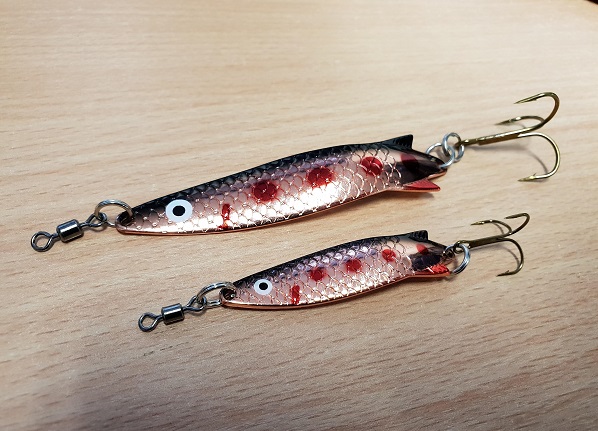In this article, we will cover off 4 fly setups that will help you land more fish during those Autumnal sessions.
1 THE IMITATIVES
If you accept that other than some of the smaller buzzer species, most fly hatches now cease, then the surface action tends to be with terrestrials such as the ever-reliable daddy longlegs. Even when the insect is no longer around, an inquisitive trout will often come to take one, especially if you make it create a slight wake in the surface.
A sunk Daddy seems really good right now and although – of course – there’s no such thing as an underwater, swimming daddy, the trout don’t seem to know that and will gladly take one.
Our recommended choice of patterns for this time of the year does often rely on using a Daddy variant. You can use a floating close copy, a slow sinker or go mad and use ones with coloured bead heads and rubber legs. They all work!

There are two ways of doing this. One is to put a dry Daddy on the dropper and then use a lightly-dressed Buzzer or basic nymph such as an original Diawl Bach on the point. Alternatively, put a sinking Daddy on point with the dropper position for the nymph. You will be surprised as to how often the nymph is taken. Fish are attracted to the Daddy but then move on to the smaller fly and take it so gently as though it’s a little snack.
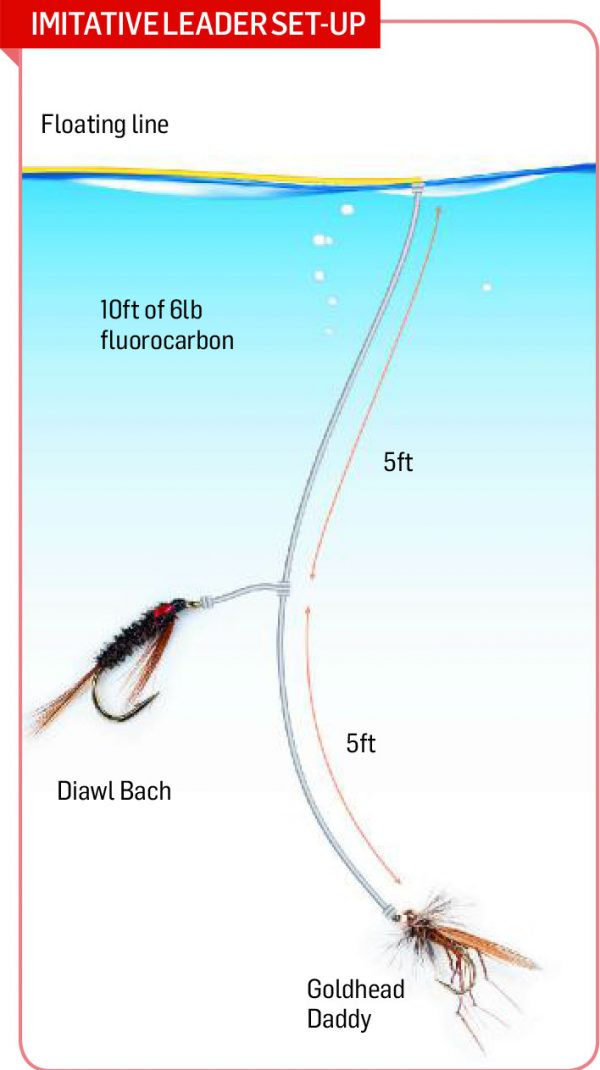
If you have the opportunity and good light it can pay to watch someone else fishing and observe the fishes’ reactions to the way they fish the fly and indeed, how often they get takes which go undetected. This is the way that good guides develop their expertise – by continually watching their clients, and the fish.
Recommended Flies
Daddy Hog
from £1.30Mini Foam Daddy
from £1.30Daddy Longlegs
from £1.30Pearly Daddy
from £1.30Olive Damsel
from £1.30CDC Daddy
from £1.30
Red Nemo Cruncher
from £1.30Olive Diawl Bach
from £1.30Diawl Bach Mirage
from £1.30Diawl Bach Black Flashback
from £1.30Montana Nymph
from £1.30Nemesis Unweighted Nymph
from £1.30
Nymph Retrieves
This set-up can be left static most of the time but don’t be afraid to occasionally twitch the flies so that the Foam Daddy creates a wake on the surface. This commotion often attracts a fish or two, even if there are no natural daddies falling onto the water. The beauty of this two-fly set-up is that, if the fish refuse to take the Foam Daddy, they may well turn and take the nymph.
2 TRADITIONAL WET COMBO
Traditional wets are brilliant autumn patterns. They often don’t really imitate anything in particular but ‘suggest’ all manner of things and with the trout now in feeding and inquisitive mode you can have a lot of fun with a team of two or three ‘proper’ flies.
Equally effective with floating or sinking lines, it’s best to look at the prevailing conditions on the day and choose whether or not to fish the surface layers or go down a bit. Blustery, cool days will have us looking for the intermediate while the mild and sunny days suit the floating line approach.
There’s no need for a fast retrieve but, as with all vaguely imitative patterns, there’s much to be gained from careful attention on the lift-off prior to casting again. Time after time we find we get fish this way. We like to think of it as the fly being taken out of the water and the fish having to make its mind up on a ‘take it or leave it’ basis. A little bit of a wiggle with the rod tip is no bad thing at this last part of the retrieve because it seems to act as a final inducement.
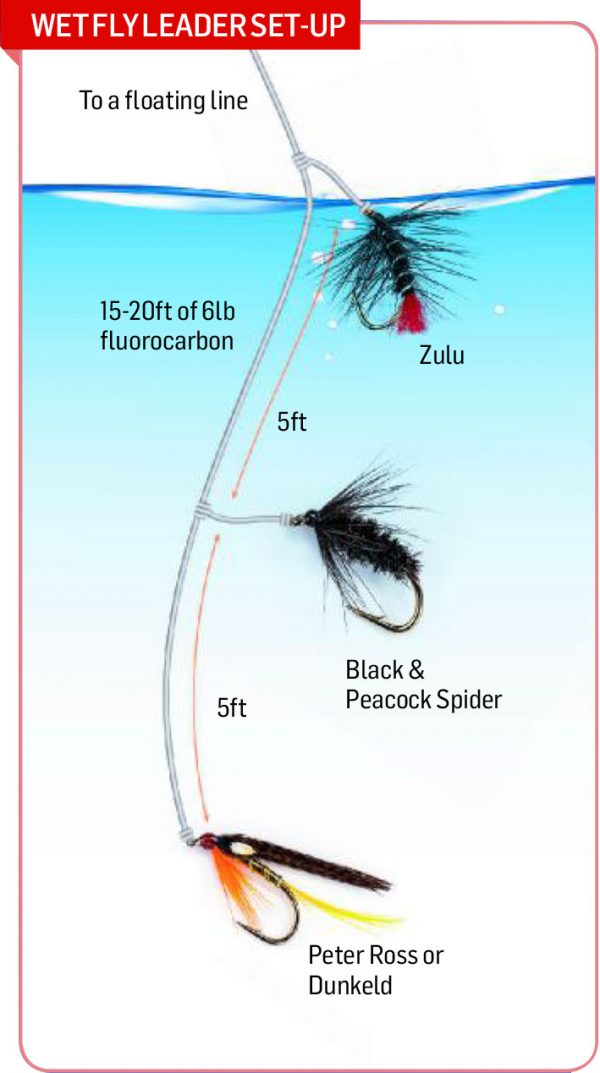
Putting together a favourite three-fly leader would see us using a point fly of either a Peter Ross or maybe a Dunkeld if it’s a bright and sunny day. Middle dropper will be either a Black & Peacock Spider or Williams Favourite and the top dropper is always a bit more of a hackled option to create a little fuss and disturbance on the lift-off. It’s hard to go wrong with either a Claret Bumble or the ever-reliable Zulu.
Recommended flies
Invicta
from £1.30Silver Invicta
from £1.30Yellow Owl
from £1.30Pearly Medicine
from £1.30Teal & Green Winged Wet
from £1.30Bog Fly
from £1.30
Doobry
from £1.30Kill Devil Spider
from £1.30Red Zulu
from £1.30Bibio & Red
from £1.30Blue Zulu
from £1.30UV Pennell
from £1.30
Wet Retrieves
Wet flies should be pulled. The idea is to get the fish to chase what are, in the main, forms of mini lures. The bigger the wave, the faster the retrieve and hopefully you’ll get that incredible bow wave as a fish locks on and follows the flies. Then, just before lifting off to re-cast, dibble the flies with rod held high and vibrate the top dropper on the surface. The fish will be attracted to this and forced to make a decision, to take!
3 LURE COMBOS
If ever there was an autumn colour for a lure choice then our number one will always be orange. Maybe it’s something to do with the foliage colours, but more likely the recommendations from many of our customers at this time of year.
The good old Whisky Fly was such a hot lure and although we think it’s not much more than a grown-up Dunkeld it was the supreme late-season fly for many years. Then marabou and synthetics came along and spawned a whole range of new lures but it’s that orange colour that remains dominant for this time of year.
Even the mighty ‘Blob’ in its original orange format is a killer and whether or not you think it resembles a cluster of daphnia doesn’t matter because it works. As for our choice of autumn lures, it will be hard to go wrong with a basic Orange rocket taddy or hot orange bunny leech as your point fly and have something much simpler on the dropper.
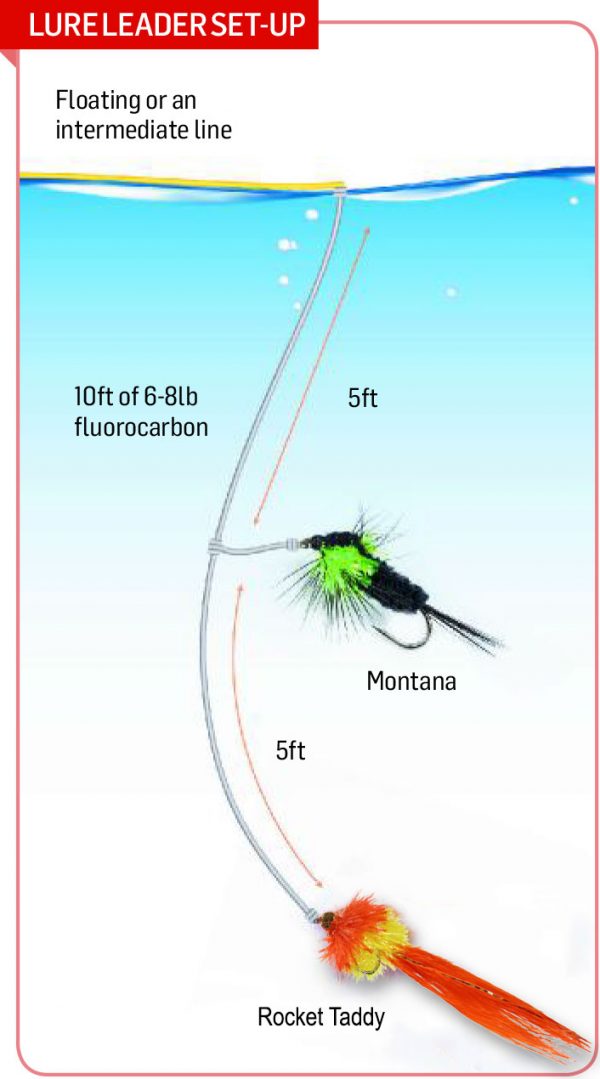
We know that our dropper choice could be classed as a nymph but it’s only in the far west of the USA that it might actually be imitating a stonefly nymph so the ever-reliable Montana with an orange thorax is our favoured pattern. It’s got the colour and a bit of action from the palmered hackle, plus it’s a good ‘chased’ fly with the lure behind it.
It’s probably as well to fish the lure combination with the intermediate line and, of course, you can try all manner of retrieves from a crawl to a roly-poly. Rainbow trout are aggressive feeders at this time of year and you often get the most exciting follows as they home in on the lure, so remember that it’s usually best to speed up the retrieve when you see a follow.
Recommended Flies
Ally McCoist
from £1.30Deadly Damsel
from £1.30Rainbow Warrior
from £1.30Yellow Dancer
from £1.30Ms Damsel
from £1.30Black Dancer
from £1.30
Lure Retrieves
Lures should be retrieved erratically, so vary the style of retrieve even during one drawback before recasting. Try to impart as much life into the marabou tail as possible because it’s the movement that the fish find attractive. If the trout are in chasing mood and eager to follow the lures at speed, try a roly-poly retrieve which involves placing the rod butt under your arm and then using a hand-over-hand motion to retrieve the fly line back. This retrieves the flies back at a continuous speed, which is sometimes very successful. But it often pays to vary things up with short pauses and short or long strips or slow pulls and a figure-of-eight in-between. Once you’ve discovered the retrieve type and speed, focus on that.
4 INDICATOR COMBOS
Undoubtedly deadly, even if there might not be much casting involved but you can use a dry fly as your indicator and double up the chances of a fish, especially if you use a Deer Hair Daddy or Deer hair sedge. These are great floaters and a sort of eye candy for a hungry trout. Takes to these dry indicators are very often a huge, enthusiastic swirl and sometimes the fish part rolls out of the water to take it down.
Takes to these dry indicators are very often a huge, enthusiastic swirl and sometimes the fish part rolls out of the water to take it down.
Still going with the orange autumn theme we find that an Okey Dokay is really effective as the point fly around two to three feet down, and so too is a simple Orange Blob.
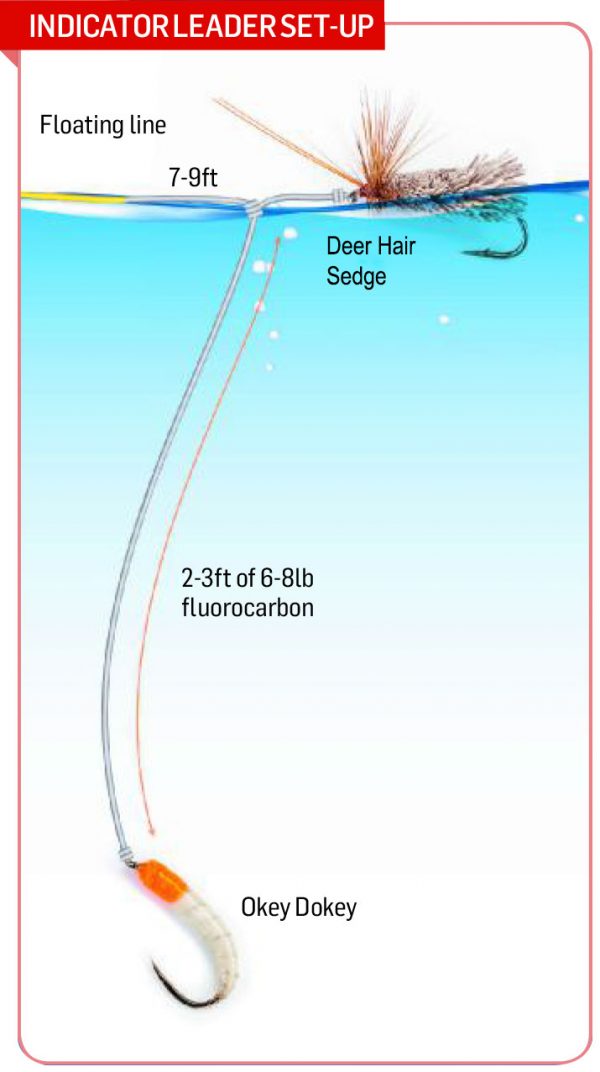
If you don’t fancy using a dry fly as your indicator then there are lots of readymade ones to choose from and it pays to have a few colour choices dependent on the light conditions. As you can imagine, an orange indicator can bring a few ‘takes’ from over-eager trout at this time of year.
You can easily suspend two flies under an indicator to your choice of depth and then maybe team up your orange option with a simple Flexi-Floss Bloodworm. One little tip for you here with indicators is to have a steeply-tapered leader and not more than around 10 feet. It’s much easier to turn over the bulky, and air-resistant indicator like that because the power of your cast is more efficiently put to the leader.
Recommended Flies
Sedgehog Yellow Owl
from £1.30Kate McLaren Muddler
from £1.30Red Arse Green Peter Sedge
from £1.30Black Muddler
from £1.30Loch Ordie Muddler
from £1.30Muddler Damsel
from £1.30
Indicator Retrieves
Obviously, leave static for the most part but given that you’re using a buoyant, imitative fly as an indicator, it pays to impart a few twitches here and there. Remember too, that the Deer hair sedge represents a sedge and the naturals do skitter about on the water’s surface so the trout will be used to seeing a fly like this being moved. As mentioned earlier the fish are attracted to the surface commotion and will often take the Okey Dokay if they don’t fancy the Sedge. Furthermore, you’ll occasionally attract a bow wave if you use a continuous retrieve so that the Sedge creates a wake on the water.
If you require any more information on winter trout fly fishing, please contact the Angling Active team. We are more than happy to help









































